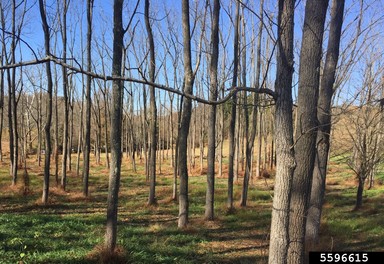black walnut
Juglans nigra

Description:
Juglans nigra, also known as the Eastern black walnut, is a species of deciduous tree in the Juglandaceae family. It is native to the Eastern United States and can be found from southern Ontario and Quebec, to the Gulf of Mexico, including Wisconsin.
Morphologic characteristics of Juglans nigra include:
- large tree, reaching heights of up to 100 feet
- straight trunk, with a dark brown, deeply furrowed bark
- pinnately compound leaves, with 11-23 leaflets that are lanceolate to ovate in shape
- male and female flowers on separate trees, with the males being in drooping catkins, and the females being small and inconspicuous
- large, round, green fruit, which mature in September to October and contain a large, edible, oily nut encased in a thick, hard shell
It can be found in different habitats such as bottomlands and well-drained uplands, and it’s also commonly used as a shade tree, and for its wood and nuts.
Details:
black walnut
| USDA Symbol: | Common Name: | Scientific Name: |
|---|---|---|
| JUNI | black walnut | Juglans nigra |
ITIS TSN: 19254
Category: Dicot
Taxonomy
Kingdom: Plantae
Subkingdom:
Super Division: Spermatophyta
Division: Magnoliophyta
Subdivision:
Class: Magnoliopsida
SubClass: Hamamelididae
Order: Juglandales
Family: Juglandaceae
Counties:
| NR40 Listed Plant | Noxious Weed: | Invasive Species (NR40): | Threatened/Endangered: | WI Natural Heritage Index: | Wetland Status |
|---|---|---|---|---|---|
| FACU |
Active Growth Period: Spring
Bloat: None
Carbon to Nitrogen Ratio: High
Coppice Potential: Yes
Conspicuous Fall Color: No
Fire Resistant: No
Flower Color: Yellow
Conspicuous Flower: No
Foliage Color: Green
Foliage Light Porosity Summer: Porous
Foliage Porosity Winter: Porous
Foliage Texture: Medium
Fruit/Seed Color: Brown
Growth Form: Single Stem
Growth Rate: Rapid
Height at Base Age (Max): 35
Height at Maturity: 100
Known Alelopath: Yes
Leaf Retention: No
Lifespan: Moderate
Re-sproutability: Yes
Shape and Orientation: Erect
Toxicity: Slight
Height (min):
Height (max):
Root Type:
Leaf Type:
Leaf Arrangement:
Leaf Shape:
Vein Pattern:
Adapted to Coarse Textured Soils: No
Adapted to Medium Textured Soils: Yes
Adapted to Fine Textured Soils: No
CaCO3 Tolerance: High
Cold Stratification Required: No
Drought Tolerance: Low
Fertility Requirement: High
_Fire Tolerance: High
Hedge Tolerance: None
Moisture Use: High
pH (Minimum): 4.6
pH (Maximum): 8.2
Planting Density per Acre, Minimum: 100
Planting Density per Acre, Maximum: 800
Precipitation (Minimum): 30
Precipitation (Maximum): 60
Root Depth, Minimum (inches): 40
Salinity Tolerance: None
Shade Tolerance: Intolerant
Temperature, Minimum (°F): -28
Plant Spacing (min):
Plant Spacing (max):
| Bloom Period: | Commercial Availability: | Fruit/Seed Abundance: |
|---|---|---|
| Late Spring | Routinely Available | Low |
| Fruit/Seed Period Begin: | Fruit/Seed Period End: | Fruit/Seed Persistence: |
|---|---|---|
| Fall | Fall | No |
| Propogated by Bare Root: | Propogated by Bulbs: | Propogated by Container: |
|---|---|---|
| Yes | No | Yes |
| Propogated by Corms: | Propogated by Cuttings: | Propogated by Seed: |
|---|---|---|
| No | Yes | Yes |
| Propogated by Sod: | Propogated by Sprigs: | Propogated by Tubers: |
|---|---|---|
| No | No | No |
| Seeds per Pound: | Seed Spread Rate: | Seedling Vigor: |
|---|---|---|
| 40 | Slow | High |
| Small Grain: | Vegetative Spread Rate: | Propagation Treatment: |
|---|---|---|
| No | None |
| Days to Stratify: | Direct Sowing Time: |
|---|---|
Benefits:
| Berry/Nut/Seed Product: | Christmas Tree Product: | Fodder Product: |
|---|---|---|
| Yes | No | No |
| Fuelwood Product: | Lumber Product: | Naval Store Product: |
|---|---|---|
| High | Yes | No |
| Nursery Stock Product: | Palatable Browse Animal: | Palatable Graze Animal: |
|---|---|---|
| Yes | Low | Low |
| Palatable Human: | Post Product: | Protein Potential: |
|---|---|---|
| Yes | No | Low |
| Pulpwood Product: | Veneer Product: |
|---|---|
| No | Yes |
| Benefits: | Wildlife Food Value: | Wildlife Cover Value: |
|---|---|---|
References:
- Burns, Russell M., Honkala, Barbara, H. Silvics of North America, Volume 2, Hardwoods. United States Department of Agriculture (USDA), Forest Service, Agriculture Handbook 654, pages 391-399.
- iNaturalist Database – Juglans nigra
- Smallwood, Christopher J.; Ethington, Matthew J.; Ginzel, Matthew D. Managing Thousand Cankers Disease in High-value Plantings of Black Walnut (Fagales: Juglandaceae) in Washington State. Journal of Integrated Pest Management, Volume 13, Issue 1, 2022, 5.
- USDA Plants Database – Juglans nigra
- USFS Fire Effects Information System – Juglans nigra
- Wisflora Database – Juglans nigra
Return to Native Plants page
